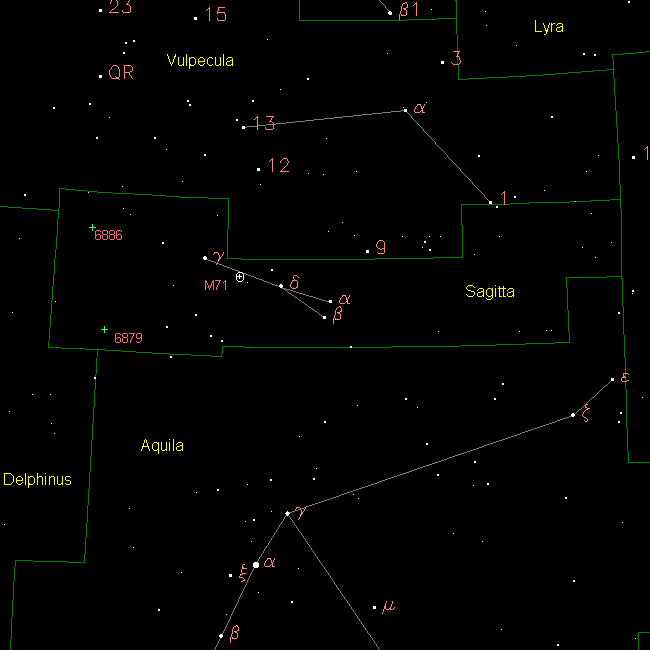[/caption]
Sagitta belongs to the original 48 constellations charted by Ptolemy and it remains one of the 88 modern constellations defined by the International Astronomical Union. Located north of the ecliptic plane, it spans 80 square degrees of sky, ranking 86th in constellation size. Sagitta contains 4 main stars in its asterism and has 19 Bayer Flamsteed designated stars within its confines. It is bordered by the constellations of Vulpecula, Hercules, Aquila and Delphinus. Sagitta is visible to all observers located at latitudes between +90° and ?70° and is best seen at culmination during the month of August.
In ancient history, the constellation of Sagitta was once known as Sham – a name applied today to its Alpha star. It was the Romans who named it Sagitta, the “Arrow”. In ancient Greek myth, it depicted the weapon which Hercules used to kill the eagle Aquila – or perhaps the Stymphalian birds. Perhaps it is Cupid’s Arrow, or the one which the Centaur shot at Chiron… No matter which tale you choose, it’s unmistakeable arrow shape was clear to all cultures, including the Persians, Hebrews, Greeks and Romans. Only Johann Bayer seemed to have trouble with it… For it is one of those constellation in which he named the bright stars out of order!
Let’s begin our binocular tour of Sagitta with Alpha – the “a” symbol on our chart. While Sham isn’t the brightest star in the constellation, this yellow bright giant star’s name really does mean “arrow”. Located about about 475 light years from Earth, it has a stellar luminosity 340 times that of the Sun and is about 20 times larger. Sham falls inside the “Hertzsprung Gap,” a perimeter of stellar temperature and luminosity that few stars fit inside. From its point in stellar evolution, it should have stopped fusing hydrogen to helium and began to brighten. However, that’s not the case. For some reason, Sham’s surface shows an abundance of nitrogen – a state which could only occur from interior helium fusion. A Cepheid variable star in the making? Perhaps!
Take a look at Beta in binoculars – the “B” symbol on our map. It’s G-type yellow star like our own Sun. Beta Sagittae is a giant star and, like Sham, is only about 467 light years away from our solar system. Delta, in the center of the arrow, is a spectroscopic binary star. It consists of a class M giant star and a quiet little hydrogen fusing dwarf star. Both are happy at a distance of about 448 light years from here and both happily separated from each other by a little less than 9 AU. Don’t forget red giant star, Gamma, either! The “Y” star on our chart might be 275 light years away, but it shines 640 times brighter than our Sun! It, too, is highly evolved…. Surrounded by a shell and well on its way to becoming a Mira-type variable star and eventually a white dwarf star about the size of the Earth.
For large binoculars and small telescopes, set your sights towards Messier 71 (RA 19 : 53.8 Dec +18 : 47). At around 8th magnitude, this loosely structured globular cluster is a challenge for smaller optics, but a wonderful study. It was originally discovered by Philippe Loys de Chéseaux in 1746 and included by Charles Messier in his Messier catalog of comet-like objects in 1780. Residing about 12,000 light years away and spanning about 27 light years across, there has long been a debate about this star cluster’s proper designation… globular cluster or concentrated galactic star cluster? Thanks to modern photometry, astronomers have detected a short “horizontal branch” in the H-R diagram of M71, which is characteristic of a globular cluster. Its low metallicity content has now been recognized as that of a “youthful” globular cluster and its lack of RR Lyrae variables places it at an age of between 9 and 10 billion years old.
For two challenging large telescope studies, let’s try your hand with planetary nebulae. The first is NGC 6879 (RA 20 : 10.5 Dec +16 : 55). At an apparent magnitude of 13, this challenging study will require high magnification and careful alignment to pick out from the stellar field. However, don’t be discouraged, because the nebula itself is rather bright and conspicuous as a “hairy star”. Just as challenging is NGC 6886 (RA 20 : 12.7 Dec +19 : 59). While the central star is a magnitude brighter at 12, you’re going to need at least an 8″ telescope to detect this one. It has an unusual chemical composition which an OIII filter helps to reveal.
Sources:
Wikipedia
Chandra Observatory
SEDS
Chart Courtesy of Your Sky.

